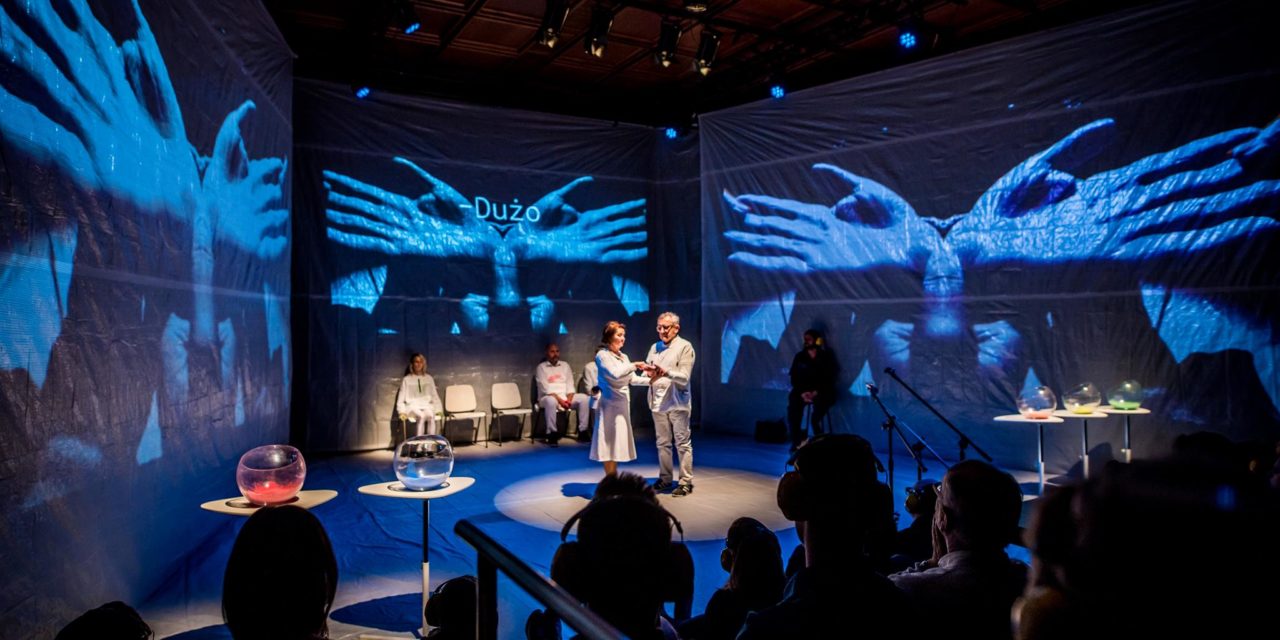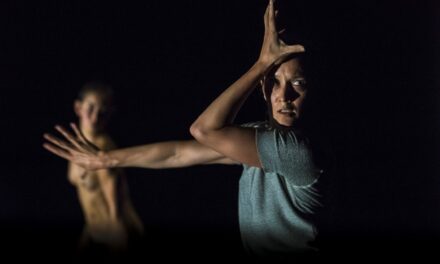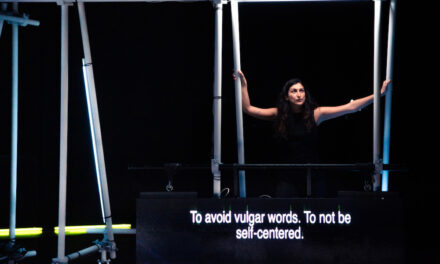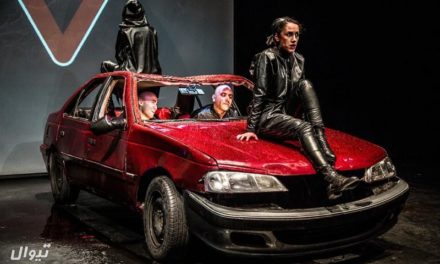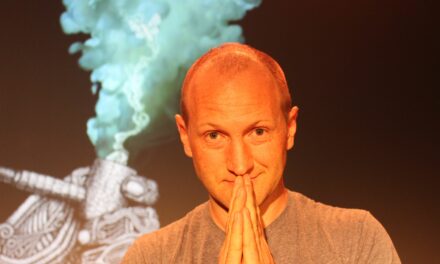“Freedom, Equality, Theatre”
The motto of Scena Robocza (Working Scene) is, “Freedom, Equality, Theatre,” and these elements are on full display in the company’s piece Nie Mów Nikomu (Do Not Tell Anyone). A multimedia performance piece, Nie Mów Nikomu is built around the true-life stories of five deaf people in Poland. The performance is simultaneously a beautiful piece of live art and an educational piece of activism about disability. Nie Mów Nikomu provides a space on the Polish stage for the subject of deaf life, but it does not do so with pity or exoticization. Instead, it portrays its subjects as equal to anyone else in the room—not “disabled” as much as “differently abled.”
Since its 2016 premiere, Nie Mów Nikomu has traveled around Poland, but its home base is Poznań. The play’s director, Adam Ziajski, is a staple of the Poznań artistic scene. He is also currently artistic director of Scena Robocza, which has its home base in Poznań’s downtown Centrum Rezydencji Teatralnej. This large, mainly abandoned building was a cultural center, but currently only houses a few performance spaces, including the black box on its fourth floor in which Nie Mów Nikomu was performed on 26 October 2017.
Nie Mów Nikomu: the Initial Scene
From the perspective of a hearing audience, Nie Mów Nikomu uses abstract visuals, sound, and a reversal of who is “normal” to create an almost first-person feeling experience what it is like to be deaf. As spectators enter the theatre, each one is given a set of large, over the ear, noise-canceling headphones like those worn by industrial workers. The black box has an audience on one side with raked seating looking down on the playing space. The theatre’s walls are covered in white material. Sitting downstage on pedestals are large, clear bowls of a colored substance—blue, red, yellow, green, and pink. Later, the spectators learn that the colored material is chalk. There are also microphones on stands set up downstage center. Upstage are five empty chairs. Once the audience is seated, the director, Adam Ziajski, enters in an Army-green jacket, knit cap, and jeans. He carries on his back a device reminiscent of a metal detector, but it ends in an antennae-like metal protrusion. He dips the sensor into a tight pool of light, and, when he does, an incredibly loud sound screeches out of speakers making any spectator who has not yet put on the headphones scramble to do so. Whenever Ziajski waves the wand through the light, the sound occurs, and, projected onto the walls, are images of sound waves. Eventually, Ziajski enters the circle, and the discordant sound becomes continuous for the rest of the performance.
After this initial scene, and once the painfully loud sound has begun, the play’s subjects enter, all in simple white costumes, to sit in the upstage chairs. Notably, none of these performers needs ear protection. This is the first sign that the actor/characters are deaf. But, more importantly, it is also the first way that the hearing audience is made to feel like the abnormal ones in the room. The deaf actors are perfectly comfortable with the ear-splitting noise buzzing about the theatre. Hearing spectators, on the other hand, even with the headphones, are subjected to a sound throughout the performance that just borders on discomfort. This clever device, then, normalizes the bodies of the deaf actors and makes a hearing body an encumbrance.
Telling the Stories
Ziajski then removes the microphones and leaves the stands holding the negative space of microphones, and the play tells the stories of five deaf people: Jacek Frąckowiak, Zofia Mądra, Kazimierz Mądry, Natalia Nowak, and Piotr Nowak. The people whose story it tells are also the play’s performers, lending it a documentary air.
![Piotr Nowak in„Nie Mów Nikomu” [Do Not Tell Anyone], dir. by Adam Ziajski, Scena Robocza, Poznań, Photo by Maciej Zakrzewski](https://thetheatretimes.com/wp-content/uploads/2017/12/Nie-Mow-Nikomu-Picture-3-300x200.jpg)
Piotr Nowak in „Nie Mów Nikomu” [Do Not Tell Anyone], dir. by Adam Ziajski, Scena Robocza, Poznań, Photo by Maciej Zakrzewski
After Piotr and Natalia, each tell their stories through sign with colored-chalk hands, the projected words on the screen explain that Ziajski is going to go through the audience and ask spectators to write down words that the performers will create signs for. Ziajski brings the cards on which spectators have written down words up to the performers, and, one by one, they engage in a group activity of creating a new sign, on the spot to represent the word, which is also projected behind them in the text. Beyond being an extremely entertaining segment of the show, it also demonstrates the flexibility of sign language, that it is no more static than any spoken language. It also puts a hearing audience member in the position of a deaf person because the conversation that happens via sign between the performers is not typed out onto the screen. So, as they discuss how best to represent in sign the word they have been handed, a hearing audience member who does not know sign is trapped outside of language, merely watching gesture. That is one way that this play situates hearing spectators as the “non-normal” bodies in the room. Another way the play does this is just before the improvised sign segment.
Interrupting Audience Expectation
Immediately preceding the creation of new signs, Ziajski approaches Piotr and attempts to communicate with him. With the overwhelming noise and headphones, it is impossible to hear anything Ziajski says, and the signs that Piotr uses to try to communicate with Ziajski are not transcribed onto the wall. In this way, the hearing audience is put in Ziajski’s position of not knowing what exactly is going on, or how to create meaningful dialogue. Piotr, on the other hand, is perfectly at ease, using sign to communicate to Ziajski, and represented as the competent body onstage.
These two moments—the creation of new signs and Ziajski attempting to communicate with Piotr—are two of the most clever aspects of the play because they interrupt audience expectation. After Piotr puts his hands in the chalk and signs his true-life story, Natalia does so as well. At that point, spectators may see the five actors sitting in chairs, the five bowls of chalk, and believe they understand the structure of the piece: that, one by one, each of the five performers will get up, dip their hands in chalk, and sign their stories with Polish and English projections. The fact that after Natalia’s story Ziajski tries to communicate with Piotr, and then the new sign game is played, breaks up this expectation and keeps the audience guessing.
After the game and Ziajski’s failed communication with Piotr, Jacek tells his story with colored chalk on his hands, and the audience may suspect that the play has returned to the previous pattern. But, in fact, after Jacek’s turn, the two remaining performers walk to the chalk together, with the woman, Zosia, leading the man, Kaziu. With both their hands in chalk, Zosia signs onto the palm of Kaziu because, as it turns out, he is both deaf and nearly blind. Thus, a fourth language enters the play, Lorma, the language of people who are deaf and blind. First, Zosia and Kaziu speak to one another with the words projected on the screen along with images of Zosia signing onto the palm of Kaziu. Then Zosia and Kaziu each tell their stories.
The stories themselves of these five people are by turns moving and mundane. They are, after all, describing ordinary lives of deaf people in Poland, and normalizing them. That accounts for the everyday aspects of their stories. However, they each relate facts—sometimes about deaf people’s place in Polish society, sometimes something more personal—that are surprising. For instance, it is stated that there are only 10 jobs within Poland open to deaf people and that 80% of deaf Poles are unemployed. Likewise, one describes being good at school, but being unable to complete it because of being called names like, “faggot, nerd, sissy or cunt.” Another describes her offense at the crossed ear picture representing being deaf. For her, deafness is not defined by an inability to hear, but, instead, by the ability to communicate in a different way: through sign. She explains that the sign for deaf people in her community is that of a butterfly, since deaf people move their hands like exquisite butterflies when they speak.
![Nie Mów Nikomu [Do Not Tell Anyone], dir. by Adam Ziajski, Scena Robocza, Poznań, Photo by Maciej Zakrzewski](https://thetheatretimes.com/wp-content/uploads/2017/12/Nie-Mow-Nikomu-Picture-1-1024x683.jpg)
Nie Mów Nikomu [Do Not Tell Anyone], dir. by Adam Ziajski, Scena Robocza, Poznań, Photo by Maciej Zakrzewski
Scenography and Soundscape
The design elements of this production also help create a beautiful evening, particularly its sound design (Maciej Frycz, Robert Gogol), projections (Kolektyw Wooom Visuals), and costumes (Grupa Mixer). A spectator attending a play about deaf people might expect the play to be silent. In fact, there is barely a moment of silence throughout the performance. Instead, a brilliant, discordant, soundscape blasts from speakers the entire play. A repeated motif is a beating sound, like a heartbeat, and it is heartbreaking when a character towards the end of the play signs that the only sound she has ever heard is her own heartbeat. The projections, likewise, are primarily abstract symbols that appear to be sound waves, but also from time to time project films of signing hands. This is particularly moving during the Lorma segment between Zosia and Kaziu when the walls are covered with a kaleidoscope of a woman’s hands signing into the palms of a man’s hands. Finally, the costumes, which seem like simple, white garments at the beginning of the performance, end up being extremely elegant by the finale. At the end of the performance, the chalk from the performer’s hands is traced along their white costumes providing a striking visual of the performer’s words and emotions from the evening.
Adam Ziajski graduated from Cultural Studies at Adam Mickiewicz University in Poznań, and Nie Mów Nikomu is an extremely successful combination of ethnography and performance. Its success lies in its blend of discomfort and beauty, and its amalgamation of the opposites represented by spectacle and multiple languages. Though it is not “realism,” it is real in an important way since the performers are the actual people the play is about. It is docudrama, then, but instead of spectators sitting outside and viewing a world being discussed, the experience of being deaf is made the norm onstage and a hearing audience member experiences being outside the norm. The clever combination of four languages onstage, alongside brilliant images, moving life stories, and an overwhelming sound design that requires ear protection for hearing audience members, combine to create a space on the Polish stage for an important, and not often discussed aspect, of life in Poland. In this way, the play lives up to the ideals of Scena Robocza (Working Scene): “Freedom, Equality, Theatre.”
Nie Mów Nikomu (Do Not Tell Anyone) directed by Adam Ziajski, produced by Scena Robocza. Poznań. 26 October 2017 (First Performed November 25, 2016).
This post was written by the author in their personal capacity.The opinions expressed in this article are the author’s own and do not reflect the view of The Theatre Times, their staff or collaborators.
This post was written by Jacob Juntunen and Dagmara Krzyżaniak.
The views expressed here belong to the author and do not necessarily reflect our views and opinions.

